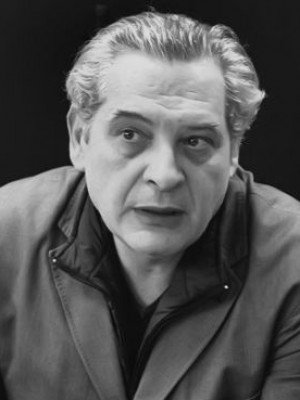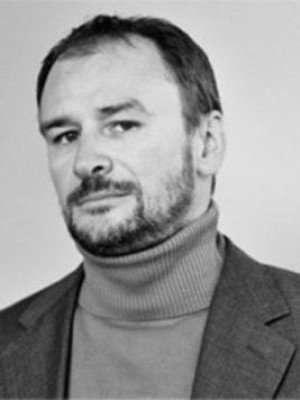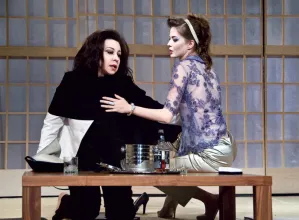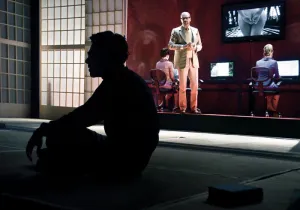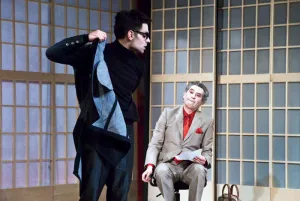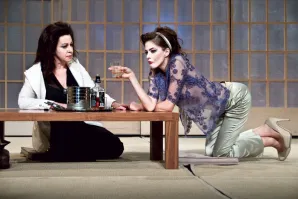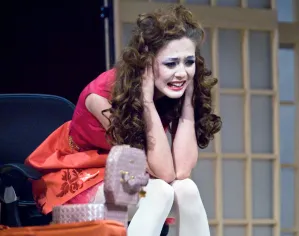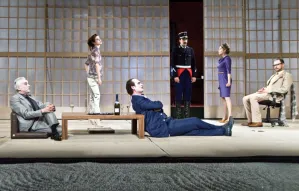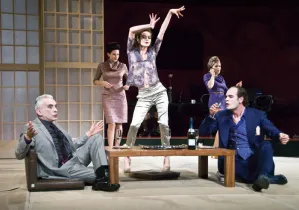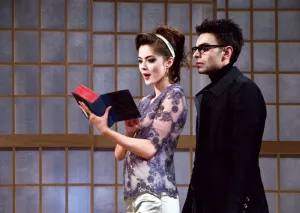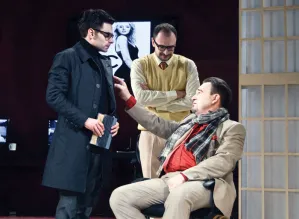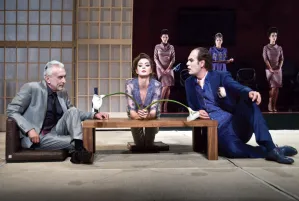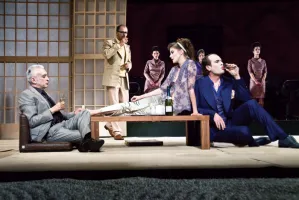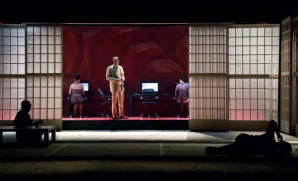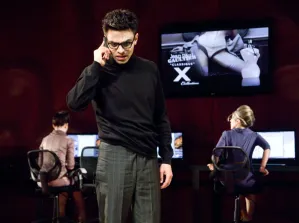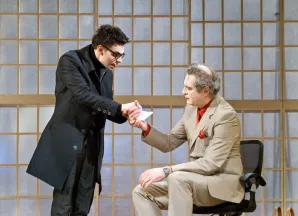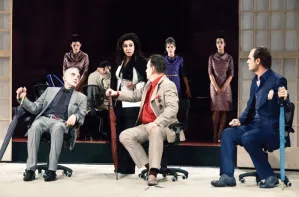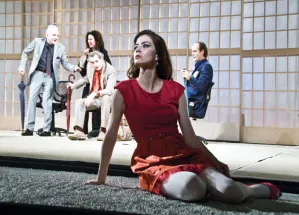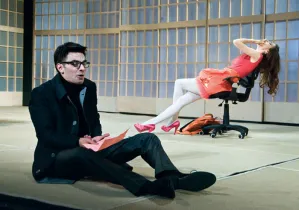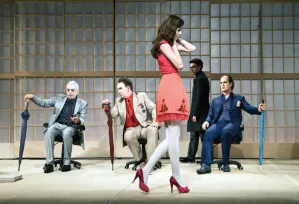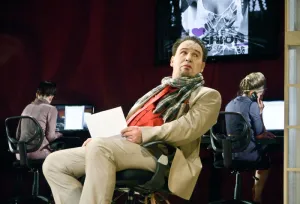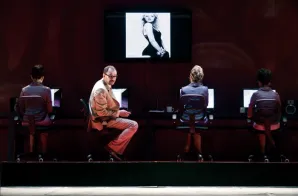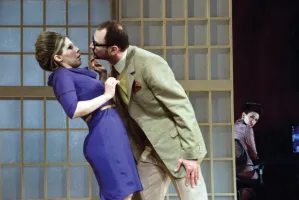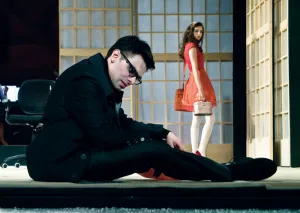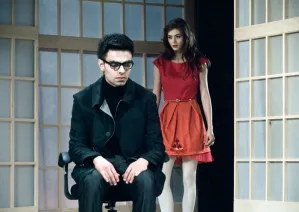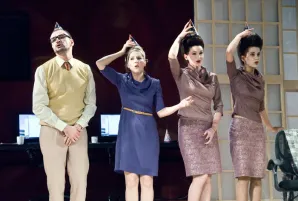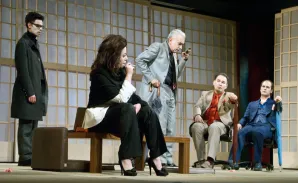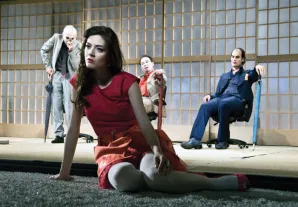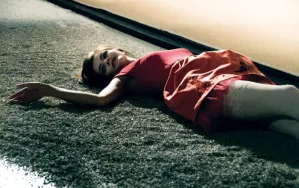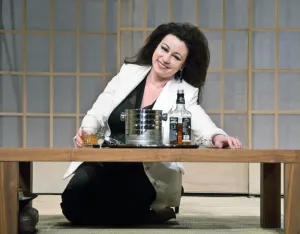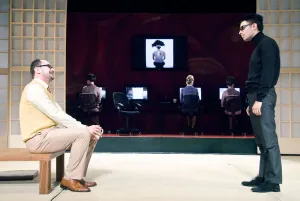The misanthrope
comedy by J. B. P. Moliere

MOLIERE’S FINAL CURTAIN
“The Hypochondriac is Molière’s final curtain; at its fourth performance, on 17 February 1673, in Palais Royal in Paris, the great playwright acted for the last time in his life. He has already been seriously ill, but he confronted death by writing a drama in which he ridicules both illness and doctors. On the day he died, he decided to go on and play the main role, regardless of advice by his wife and Baron, an actor, who both anticipated his death in short time. “’What else can I do’, he responded, ‘fifty people make a living from the performance. What will happen to them if I don’t act?’”, as de Grimarest wrote. This was actually only an excuse, because, under the disguise of responsibilities of a theatre manager, Molière hid his irresistible urge of a comedy playwright and a comedian to address everything, even the approaching death, with laughter. In the scene of a ceremony, at the moment when he says the line ‘Juro’ (I swear), Molière loses strength and noticing that audience sees that, he collects all his energy to cover the first signs of death with forced smile.” (Programme of the 300th Anniversary of Molière’s Death in the National Theatre, 1922) “Molière interpreted the role of Argan; he suddenly choked, but he managed to cover the cough. When he went to his dressing room, blood gushed on his mouth. Baron, the future great actor, who saw that, went to find Armande, Molière’s wife, also an actress. When Baron and Armande rushed in, Molière was already dead. Molière did not die on the stage, during a performance, as several great actors did – it is the kind of death actors prefer. However, he did die in the theatre, immediately after the performance, subsequent to excitement, such as premiere, and a double one, premiere of a playwright and of an actor.” (“Srpska Scena” Magazine, 1942) In 1882, the Theatre Magazine wrote about celebration the French have on 17 February every year, after mandatory performance of The Hypochondriac, “In the central part of the stage, the place where the chair of the doctor is situated, there is a post where a beautiful bust of Molière stands, the bust was sculptured by Houdon; there are numerous benches on the right and left on the stage. The curtain goes up: all members of the Théâtre français Company come, both tragic and comic, men and women. They are all dressed in red doctor’s uniforms and wearing doctor’s hats, some with medical tools – especially the giant syringes – walk in pairs. They slowly walk along the stage; audience rewards them, according to their merit, with more or less applause. Then, they sit on the benches. The last in the procession come the president and actors who played in The Hypochondriac. The music stops. The ceremony starts, as Molière wrote it. At the second “Juro”, namely the last words Molière said on the stage, all members of the company stand up, remain standing in profound silence, after which they all sit down and the ceremony continues. In the end, they all face Molière’s bust and place flowers in front of it and the oldest member puts a laurel wreath on the head of the great artist’s bust. – This is how the audiences and theatre give homage to great artists in France.”
Prepared by Jelica Stevanović
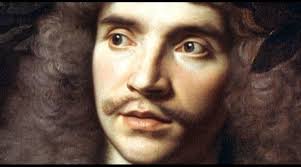 JEAN-BAPTISTE POQUELIN MOLIÈRE
JEAN-BAPTISTE POQUELIN MOLIÈRE
(January 15, 1622 – February 17, 1673)
Molière was born Jean Baptiste Poquelin in Paris, France, on January 15, 1622. His father held the post of official furnisher at the royal court. Molière was educated at the Collège de Clermont, a Jesuit institution. After that, Molière studied law briefly and was allowed to practice in 1641, but in 1643 he decided to devote himself to the theater. Since the theater life was not considered very respectable, he assumed the name “Molière” in order to spare embarrassment to his family. He joined a troupe known as the Illustre Théâtre that included Béjart and her family. By 1644, having served two prison terms as a result of the company’s debts, Molière joined another company with the Béjarts and toured all over France for the next thirteen years. In 1650 Molière became the head of the troupe, and he managed to secure the patronage (support) of the Prince of Conti. When the company was called to give a performance before Louis XIV in 1658, it was Molière’s comedy, Le Docteur amoureux, that most amused the king. The king’s brother became patron of the troupe, and Molière returned to Paris, the city of his birth. In December 1662 Molière presented a comedy, L’École des femmes, before the king. It was to be his greatest success. The play caused a protest, known as the “Quarrel of L’École des femmes”. Molière’s enemies, jealous of the king’s favor toward him, attacked him as immoral. Molière chose to answer his enemies in huge the form of a play - Critique de l’École des femmes, presented in June 1663. In May 1664 Molière was invited to perform Tartuffe ou l’Imposteur, an attack on religious hypocrisy, for Louis XIV at Versailles, France. The play angered the Society of the Holy Sacrament, a powerful religious group, and for five long years Molière struggled without success for the right to perform his play. Finally, in 1669, Tartuffe was revived with great success at the Palais Royal. Don Juan, first presented in February 1665, is considered one of Molière’s greatest plays. Later, although Molière enjoyed the personal support of the king, he struggled with illness, marital problems, and depression. Still, during this period he wrote and presented a work that shows his mastery and genius. Le Misanthrope, presented in June 1666, pleased his admirers, but it lacked the popular appeal necessary to make it a success. L’Avare, presented two years later, failed miserably, and Molière faced extreme financial problems. A comedy-ballet, Le Bourgeois gentilhomme (1670), helped bring in the public once again. In 1671 Les Fourberies de Scapin, a bright comedy similar to his early works, was presented. On February 17, 1673, during the fourth performance of his last work, Le Malade imaginaire, Molière suffered a hemorrhage while playing the role of the hypochondriac Argan. He passed away later that night at his home on the Rue Richelieu. The local priests refused to take his confession, for actors had no social standing and had been excommunicated by the church. Nor would they permit him to be buried in holy ground. Four days later, the King interceded and Molière was finally buried in the Cemetery Saint Joseph under the cover of darkness. The greatest of his plays include The School for Husbands (1661), The School for Wives (1662), The Misanthrope (1666), The Doctor in Spite of Himself (1666), Tartuffe (1664,1667,1669), The Miser (1668), and The Imaginary Invalid (1673).
www.notablebiographies.com
www.imagi-nation.com
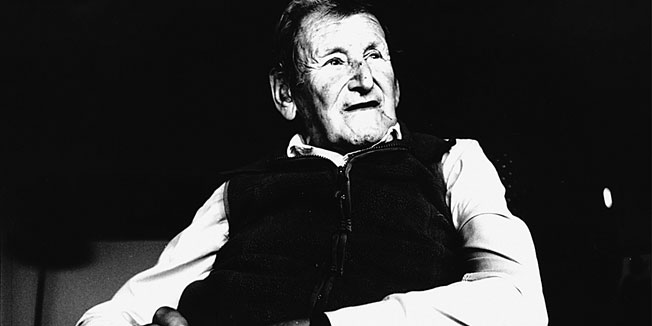 JAN KOTT (October 27, 1914, Warsaw – December 23, 2001, Santa Monica)
JAN KOTT (October 27, 1914, Warsaw – December 23, 2001, Santa Monica)
Born in Warsaw in 1914 to a Jewish family, Kott was baptized into the Catholic Church at the age of five. During The World War II he joined the communist partisan People’s Army (Armia Ludowa), and after the war he became a communist. He became known initially as the editor-in-chief of literary magazine Kuźnica and as Poland’s leading theorist of Socialist realism. In 1949, as the communist authorities tightened their control over all aspects of life in Poland, Kott obtained a position of a professor in Wrocław and moved away from political life. He renounced his membership of the communist party in 1957. Later, Kott travelled to the United States in 1966 on a scholarship from the Ford Foundation, and lectured at Yale and Berkeley. The Polish authorities refused to extend his passport after three years, at which point he decided to defect. A poet, translator, and literary critic, he became one of the more prolific essayists of the Polish school in America. As theatrical reviewer, Kott received praise for his readings of the classics, and above all of Shakespeare. In his book, Shakespeare, Our Contemporary (1964), he interpreted Shakespeare in the light of philosophical and existential experiences of the 20th century, augmented with his own life’s story. This autobiographical accent became a hallmark of his criticism. He also sought to juxtapose Shakespeare with Eugène Ionesco and Samuel Beckett. He took a similar approach to his reading of Greek tragedy in The Eating of the Gods. Kott wrote many books and articles published in American journals such as The New Republic, Partisan Review and The New York Review of Books. Aside from Shakespeare and Greek tragedy, he also wrote about Japanese theatre, Tadeusz Kantor and Jerzy Grotowski. He translated into Polish and English, works by Jean-Paul Sartre, Denis Diderot, Eugène Ionesco and Molière.
He died in Santa Monica, California after a heart attack in 2001.
Taken from: wikipedia.org
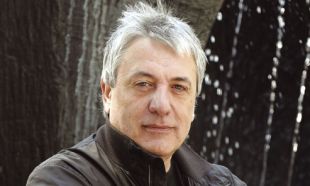 EGON SAVIN, DIRECTOR
EGON SAVIN, DIRECTOR
Egon Savin currently works as Professor of Directing at the Faculty of Drama Arts in Belgrade and at the Faculty of Drama Arts in Cetinje. He directed more than 80 plays so far. He directed guest performances in Nancy, Paris, Warsaw, Tel Aviv, Vienna, New York, etc. He has received a number of awards. Egon Savin has successfully worked in all production models in the country, starting from non-institutional theatres and off-scenes, to almost all established theatres in ex-Yugoslavia. He successfully directs plays by domestic and international classics and finds tangible clues that discover the essential power of theatre in our time and connect the plays and their authors to a specific space and time. Egon Savin has directed the following plays in the National Theatre: a comedy Cyrano de Bergerac by Rostand (premiere, 22 March 1991); Kir Janja (premiere, 25 December 1992) and Pokondirena tikva by Sterija (premiere, 18 January 1998); drama Demon by Isaac Bashevis Singer (it was played by the name of Teibele and Her Demon; premiere 15 March 2000); States of Shock by Sam Shepard (premiere, 26 October 2001) and The Dervish and Death by Meša Selimović (dramatized by Borislav Mihajlović Mihiz, adapted by Egon Savin; premiere, 27 December 2008), The Deceased (premiere, 26 December 2009).
Premiere performance
Premiere 19, may 2012 / Main stage
Translation from Polish Petar Vujičić,
translation of verses from french Radmila Miljanić Nikolić
Adaptation Jan Kott – Egon Savin
Directed by Egon Savin
Dramaturge Slavko Milanović
Set Designer Boris Maksimović
Costume Designer Lana Cvijanović
Stage Speech Lјilјana Mrkić Popović
Sound Design Vladimir Petričević
Video*: Petar Antonović and Jovan Tarbuk
Premiere Cast:
Alceste Nikola Jovanović
Philinte Aleksandar Đurica
Oronte Branko Vidaković / Nebojša Kundačina
Célimène Nina Janković
Arsinoé Dušanka Stojanović Glid
Éliante Zlatija Ivanović
Acaste Lјubivoje Tadić
Clitandre Miloš Đorđević
Guard Miloš Lalović
Manager 1 Maja Lukić
Manager 2 Valentina Velkov
Producer Jasmina Urošević
Stage Manager Sandra Žugić
Prompter Danica Stevanović
Assistent Director Ivan Pantelić
Assistent Set Designer (volunteer) Ana Jovanović
Assistent Costume Designer Sonja Mrkobrada
Assistent Producer (volunteer) Anja Ninković
* We are thankful to the Company MOVEM Fashion (Hugo Boss, Canali, Trussardi) for providing the photographs.
Make-up Dragoljub Jeremić
Light operater Miodrag Milivojević
Set crew Chief Nevenko Radanović
Sound operater Perica Ćurković
SET AND COSTUMES WERE MANUFACTURED IN THE NATIONAL THEATRE WORKSHOPS


